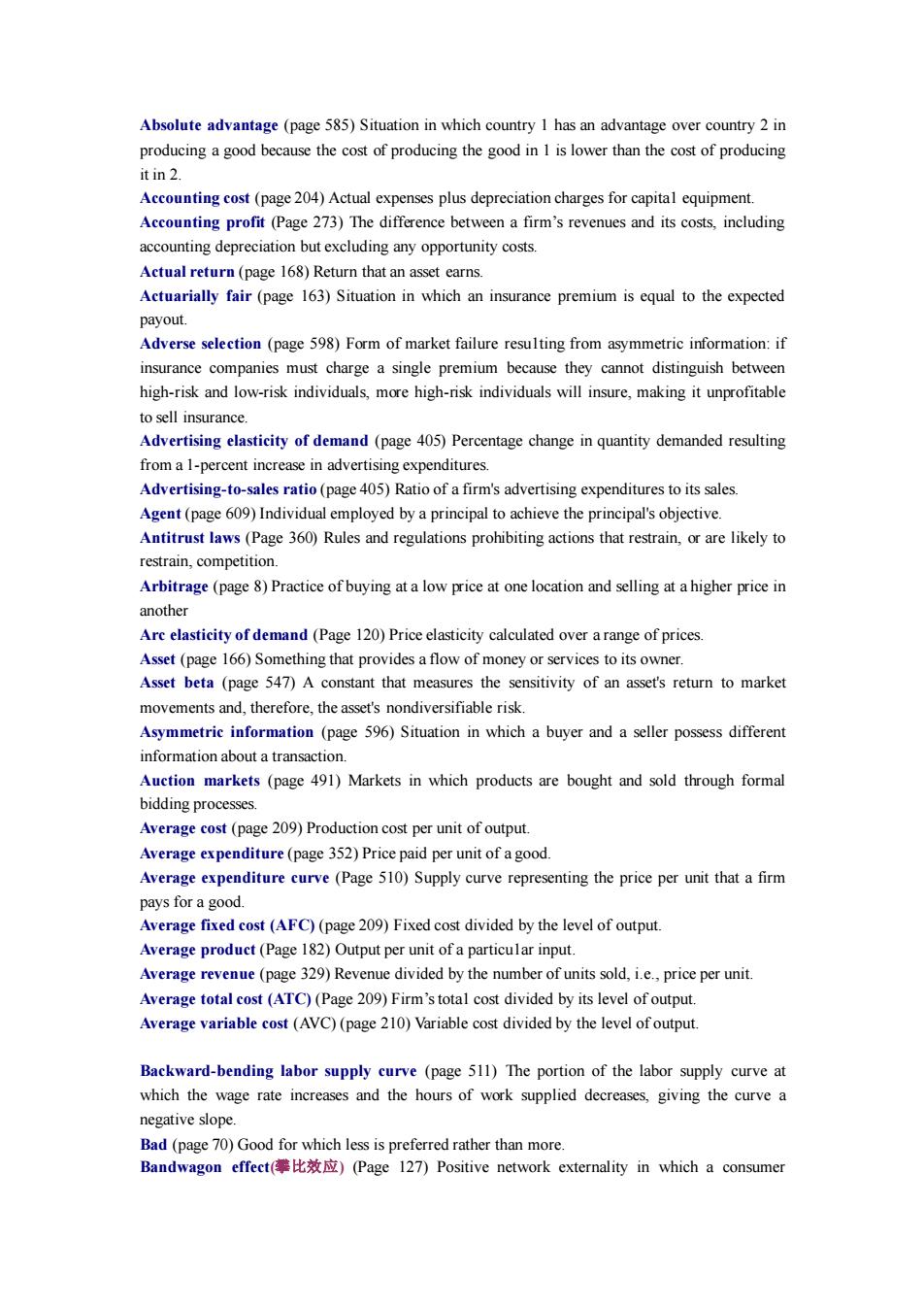
Absoute advantage (page585)Situation in which coury I has an advantage over country 2in producinga good because the of producing the good than the co of producing it in2. Accounting cost (page 204)Actual expenses plus depreciation charges for capital equipment. Accounting profit(Page 273)The difference between a firm's revenues and its costs,including accounting depreciation but excluding any opportunity costs Actual r (page 168)Return that an ass earns Actuarially fair (page 163)Situation in which an insurance premium is equal to the expected payout. Adverse selection (page 598)Form of market failure resulting from asymmetric information:if insurance companies must charge a single premium because they cannot distinguish between high-risk and low-risk individuals,more high-isk individuals will insure,making it unprofitable Advertising elasticity of demand (page 405)Percentage change in quantity demanded resulting from a I-percent increase in advertising expenditures. Advertising-to-sales ratio(page 405)Ratio of a firm's advertising expenditures to its sales. )Rulesand regulations prohibiting actions that restrain,re likely to restrain,competition Arbitrage(page 8)Practice of buying at a low price at one location and selling at ahigher price in another Are elasticity of demand (Page 120)Price elasticity calculated over arange of prices 547A constant that measures the sensitivity ofan asset's retur to marke movements and,therefore,the asset's nondiversifiable risk. Asymmetric information (page 596)Situation in which a buyer and a seller possess different information about a transaction Auction markets (page 491)Markets in which products are bought and sold through formal Average cost(page 209)Production cost per unit of output. Average expenditure(page 352)Price paid per unit of a good. Average expenditure curve(Page 510)Supply curve representing the price per unit that a firm (pag e9)Fixed cost divided by the level of oupu Average produet (Page 182)Output per unit of a particular input Average revenue (page 329)Revenue divided by the number of units sold,i.e.price per unit. Average total cost(ATC)(Page 209)Firm's total cost divided by its level of output. Average variable cost(AVC)(page 210)Variable cost divided by the level of outpu Backward-bending labor supply ve(page 511)The portion of the labor supply curve at which the wage rate increases and the hours of work supplied decreases,giving the curve a negative slope. Bad (page 70)Good for which less is preferred rather than more. Bandwagon effect(攀比效应)Page127)Positive network externality in which a consumer
Absolute advantage (page 585) Situation in which country 1 has an advantage over country 2 in producing a good because the cost of producing the good in 1 is lower than the cost of producing it in 2. Accounting cost (page 204) Actual expenses plus depreciation charges for capita1 equipment. Accounting profit (Page 273) The difference between a firm’s revenues and its costs, including accounting depreciation but excluding any opportunity costs. Actual return (page 168) Return that an asset earns. Actuarially fair (page 163) Situation in which an insurance premium is equal to the expected payout. Adverse selection (page 598) Form of market failure resu1ting from asymmetric information: if insurance companies must charge a single premium because they cannot distinguish between high-risk and low-risk individuals, more high-risk individuals will insure, making it unprofitable to sell insurance. Advertising elasticity of demand (page 405) Percentage change in quantity demanded resulting from a 1-percent increase in advertising expenditures. Advertising-to-sales ratio (page 405) Ratio of a firm's advertising expenditures to its sales. Agent (page 609) Individual employed by a principal to achieve the principal's objective. Antitrust laws (Page 360) Rules and regulations prohibiting actions that restrain, or are likely to restrain, competition. Arbitrage (page 8) Practice of buying at a low price at one location and selling at a higher price in another Arc elasticity of demand (Page 120) Price elasticity calculated over a range of prices. Asset (page 166) Something that provides a flow of money or services to its owner. Asset beta (page 547) A constant that measures the sensitivity of an asset's return to market movements and, therefore, the asset's nondiversifiable risk. Asymmetric information (page 596) Situation in which a buyer and a seller possess different information about a transaction. Auction markets (page 491) Markets in which products are bought and sold through formal bidding processes. Average cost (page 209) Production cost per unit of output. Average expenditure (page 352) Price paid per unit of a good. Average expenditure curve (Page 510) Supply curve representing the price per unit that a firm pays for a good. Average fixed cost (AFC) (page 209) Fixed cost divided by the level of output. Average product (Page 182) Output per unit of a particu1ar input. Average revenue (page 329) Revenue divided by the number of units sold, i.e., price per unit. Average total cost (ATC) (Page 209) Firm’s tota1 cost divided by its level of output. Average variable cost (AVC) (page 210) Variable cost divided by the level of output. Backward-bending labor supply curve (page 511) The portion of the labor supply curve at which the wage rate increases and the hours of work supplied decreases, giving the curve a negative slope. Bad (page 70) Good for which less is preferred rather than more. Bandwagon effect(攀比效应) (Page 127) Positive network externality in which a consumer
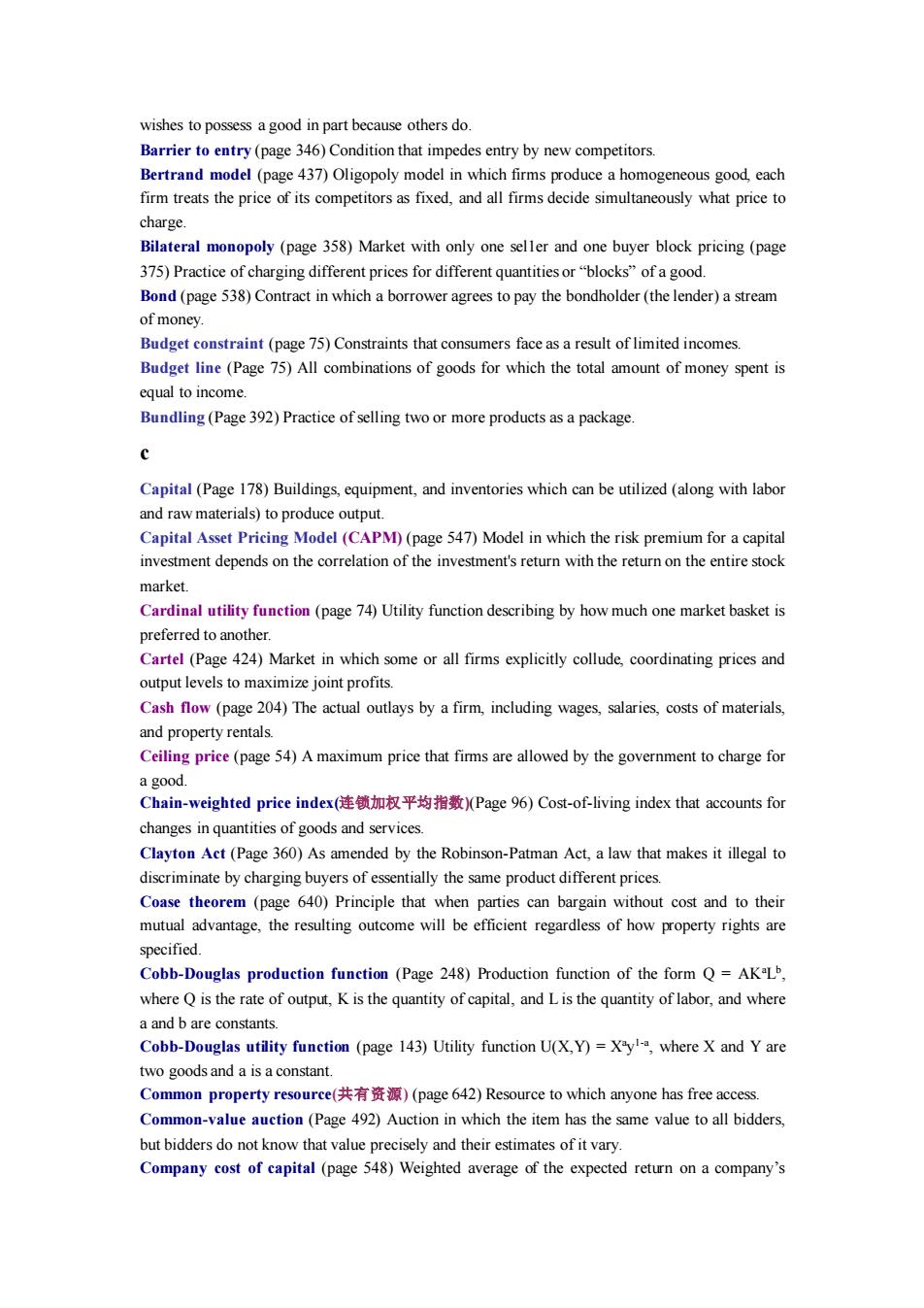
wishes to possess a good in part because others do. Barrier to(page 6)Condition that impedes entry by new competitor Bertrand model (page 437)Oligopoly model in which firms produce a homogeneous goodea firm treats the price of its competitors as fixed,and all firms decide simultaneously what price to charge. Bilateral monopoly (page 358)Market with only one seller and one buyer block pricing (page Bond(page538)Contract in whicha borrower agrees topay the bondholder (the lender)astream of money Budget constraint (page 75)Constraints that consumers face as a result of limited incomes. Budget line(Page 75)All combinations of goods for which the total amount of money spent is equal to income. Bunding(Page 39)Practice of selling twoor more products as a package Capital (Page 178)Buildings,equipment,and inventories which can be utilized(along with labor and raw materials)to produce output. Capital Asset Pricing Model (CAPM)(p ge 547)Model in which the risk prer mium for a capital tment deper on the the investment's retu with the the entire market. Cardinal utility function(page 74)Utility function describing by how much one market basket is preferred to another. Cartel (Page 424)Market in which s omeor all firms explicitly collude coordinating pices and Jont profits. Cash flow (page 204)The actual outlays by a firm,including wages,salaries,costs of materials, and property rentals. Ceiling price (page 54)A maximum price that firms are allowed by the government to charge for a good. Chain-weighted price index(连锁加权平均指数(Page96)Cost-of-living index that for changes in quantities of goods and services Clayton Act (Page 360)As amended by the Robinson-Patman Act,a law that makes it illegal to discriminate by charging buyers of essentially the same product different prices. Coase theorem (page 640)Principle that when parties can bargain without cost and to their mutual advantage.the resulting outcome will be efficient regardless of how property rights are Cobb-Douglas production function (Page 248)Production function of the formQ-AKL whereQ is the rate of output,K is the quantity of capital,and Lis the quantity of labor,and where a and b are constants Cobb-Douglas utility function (page 143)Utility function U(X.Y)X where X and Y are two goods and a is constant Common property resource(共有资a源)(page642)Resource to which anyone has free acces Common-value auction (Page 492)Auction in which the item has the same value to all bidders but bidders do not know that value precisely and their estimates of it vary. Company cost of capital (page 548)Weighted average of the expected return on a company's
wishes to possess a good in part because others do. Barrier to entry (page 346) Condition that impedes entry by new competitors. Bertrand model (page 437) Oligopoly model in which firms produce a homogeneous good, each firm treats the price of its competitors as fixed, and all firms decide simultaneously what price to charge. Bilateral monopoly (page 358) Market with only one sel1er and one buyer block pricing (page 375) Practice of charging different prices for different quantities or “blocks” of a good. Bond (page 538) Contract in which a borrower agrees to pay the bondholder (the lender) a stream of money. Budget constraint (page 75) Constraints that consumers face as a result of limited incomes. Budget line (Page 75) All combinations of goods for which the total amount of money spent is equal to income. Bundling (Page 392) Practice of selling two or more products as a package. c Capital (Page 178) Buildings, equipment, and inventories which can be utilized (along with labor and raw materials) to produce output. Capital Asset Pricing Model (CAPM) (page 547) Model in which the risk premium for a capital investment depends on the correlation of the investment's return with the return on the entire stock market. Cardinal utility function (page 74) Utility function describing by how much one market basket is preferred to another. Cartel (Page 424) Market in which some or all firms explicitly collude, coordinating prices and output levels to maximize joint profits. Cash flow (page 204) The actual outlays by a firm, including wages, salaries, costs of materials, and property rentals. Ceiling price (page 54) A maximum price that firms are allowed by the government to charge for a good. Chain-weighted price index(连锁加权平均指数)(Page 96) Cost-of-living index that accounts for changes in quantities of goods and services. Clayton Act (Page 360) As amended by the Robinson-Patman Act, a law that makes it illegal to discriminate by charging buyers of essentially the same product different prices. Coase theorem (page 640) Principle that when parties can bargain without cost and to their mutual advantage, the resulting outcome will be efficient regardless of how property rights are specified. Cobb-Douglas production function (Page 248) Production function of the form Q = AKaL b , where Q is the rate of output, K is the quantity of capital, and L is the quantity of labor, and where a and b are constants. Cobb-Douglas utility function (page 143) Utility function U(X,Y) = Xay 1-a , where X and Y are two goods and a is a constant. Common property resource(共有资源) (page 642) Resource to which anyone has free access. Common-value auction (Page 492) Auction in which the item has the same value to all bidders, but bidders do not know that value precisely and their estimates of it vary. Company cost of capital (page 548) Weighted average of the expected return on a company’s
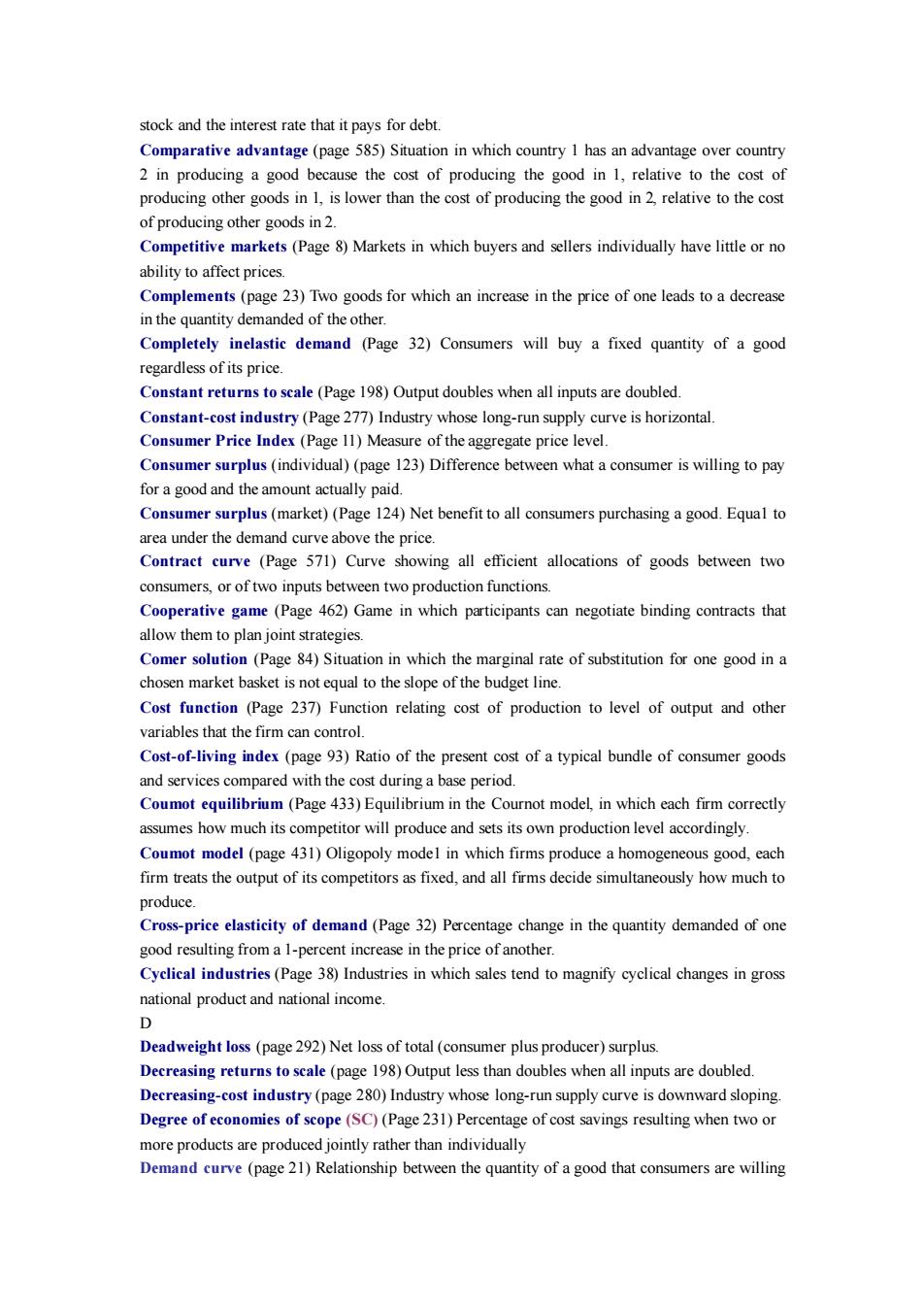
stock and the interest rate that it pays for debt 2 in producing a good because the cost of producing the good in 1,relative to the cost of producing other goods in 1,is lower than the cost of producing the good in 2 relative to the cost of producing other goods in 2. Competitive markets(Page 8)Markets in which buvers and sellers individually have little or no abilityto affect pric Complements(page 23)Two goods for which an increase in the price of one leads to a decrease in the quantity demanded of the other. Completely inelastic demand (Page 32)Consumers will buy a fixed quantity of a good regardless of its price. Constant returns toseale (Page 198)Output doubles when all inputs are doubled. Constant-cost indu ry(Page 277)Industry whose long-run supply curve is horizontal Consumer Price Index(Page 11)Measure of the aggregate price level Consumer surplus (individual)(page 123)Difference between what a consumer is willing to pay for a good and the amount actually paid. Consumer surplus(market)(Page 124)Net benefit to all consumers purchasing a good.Equal to area under the e the Contract curve (Page 571)Curve showing all efficient allocations of goods between two consumers,or of two inputs between two production functions. Cooperative game(Page 462)Game in which participants can negotiate binding contracts that allow them to plan joint strategies. Comer solution (Page8)Situation in which the al rate of substitution for one good in a osen market basket Cost function (Page 237)Function relating cost of production to level of output and other variables that the firm can control Cost-of-living index (page 93)Ratio of the present cost of a typical bundle of consumer goods nd services npared with the cs duringa base period. Coumot equili此 m(Page 433)Equilit ium in the Co ourot model,in which each firm assumes how much its competitor will produce and sets its own production level accordingly. Coumot model (page 431)Oligopoly model in which firms produce a homogeneous good.each firm treats the output of its competitors as fixed,and all firms decide simultaneously how much to produce. Cross-price elasticity of demand (Page 32)Percentage change in the quantity demanded ofone good resul ting from a I-percent increase in the price of anothe Cyclical industries(Page 38)Industries in which sales tend to magnify cyclical changes in gross national product and national income. D Decreasing return Decreasing-cost industry (page 280)Industry whose long-run supply curve is downward sloping Degree of economies of scope(SC)(Page 231)Percentage of cost savings resulting when two or more products are produced jointly rather than individually Demand crve (page21)Relationship between the quantity of a good that consumers are willing
stock and the interest rate that it pays for debt. Comparative advantage (page 585) Situation in which country 1 has an advantage over country 2 in producing a good because the cost of producing the good in 1, relative to the cost of producing other goods in 1, is lower than the cost of producing the good in 2, relative to the cost of producing other goods in 2. Competitive markets (Page 8) Markets in which buyers and sellers individually have little or no ability to affect prices. Complements (page 23) Two goods for which an increase in the price of one leads to a decrease in the quantity demanded of the other. Completely inelastic demand (Page 32) Consumers will buy a fixed quantity of a good regardless of its price. Constant returns to scale (Page 198) Output doubles when all inputs are doubled. Constant-cost industry (Page 277) Industry whose long-run supply curve is horizontal. Consumer Price Index (Page 11) Measure of the aggregate price level. Consumer surplus (individual) (page 123) Difference between what a consumer is willing to pay for a good and the amount actually paid. Consumer surplus (market) (Page 124) Net benefit to all consumers purchasing a good. Equa1 to area under the demand curve above the price. Contract curve (Page 571) Curve showing all efficient allocations of goods between two consumers, or of two inputs between two production functions. Cooperative game (Page 462) Game in which participants can negotiate binding contracts that allow them to plan joint strategies. Comer solution (Page 84) Situation in which the marginal rate of substitution for one good in a chosen market basket is not equal to the slope of the budget line. Cost function (Page 237) Function relating cost of production to level of output and other variables that the firm can control. Cost-of-living index (page 93) Ratio of the present cost of a typical bundle of consumer goods and services compared with the cost during a base period. Coumot equilibrium (Page 433) Equilibrium in the Cournot model, in which each firm correctly assumes how much its competitor will produce and sets its own production level accordingly. Coumot model (page 431) Oligopoly mode1 in which firms produce a homogeneous good, each firm treats the output of its competitors as fixed, and all firms decide simultaneously how much to produce. Cross-price elasticity of demand (Page 32) Percentage change in the quantity demanded of one good resulting from a 1-percent increase in the price of another. Cyclical industries (Page 38) Industries in which sales tend to magnify cyclical changes in gross national product and national income. D Deadweight loss (page 292) Net loss of total (consumer plus producer) surplus. Decreasing returns to scale (page 198) Output less than doubles when all inputs are doubled. Decreasing-cost industry (page 280) Industry whose long-run supply curve is downward sloping. Degree of economies of scope (SC) (Page 231) Percentage of cost savings resulting when two or more products are produced jointly rather than individually Demand curve (page 21) Relationship between the quantity of a good that consumers are willing
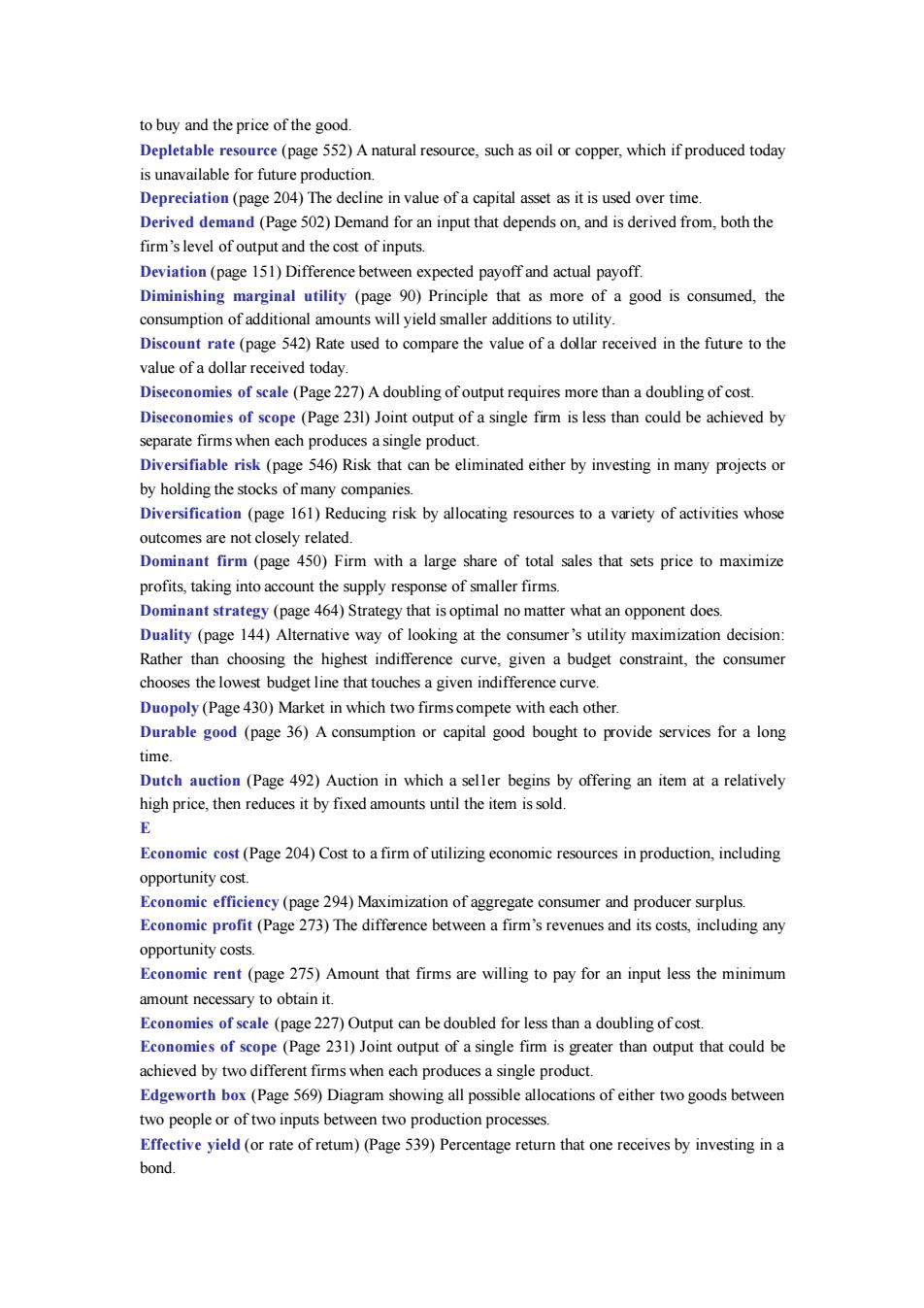
to buy and the price of the good. Depletablee(page 552).such which if produced today Depreciation (page 204)The decline in value of a capital asset as it is used over time Derived demand (Page 502)Demand for an input that depends on.and is derived from.both the firm's level of output and the cost of inputs. Deviation(page 151)Difference betwee expected payoff and actual payoff. Diminishingmar utility (page 9) Principle that t as more of a good is consumed,the consumption of additional amounts will yield smaller additions to utility. Discount rate (page 542)Rate used to compare the value of a dollar received in the future to the value of a dollar received today. Diseconomies of scale (Page 227)A doubling of output requires more than a doubling of cost scope(Page23)of a single frm is ss than cou be achieved by separate firms when each produ ces a single product Diversifiable risk (page 546)Risk that can be eliminated either by investing in many projects or by holding the stocks of many companies. Diversification(page 161)Reducing risk by allocating resources to a variety of activities whose outcomes are not c sely related (page 450)Firm with a large share of total sales that sets price to maximize profits,taking into account the supply response of smaller firms Dominant strategy (page 464)Strategy that is optimal no matter what an opponent does. Duality (page 144)Alternative way of looking at the consumer's utility maximization decision Rather than choosing the highest indiffere curve.givena budget consraint,the chooses the lowe bud hes a given indiffer Duopoly (Page 430)Market in which two firmscompete with each other Durable good (page 36)A consumption or capital good bought to provide services for a long time Dutch auction (Page 492)auction in which a seller begins by offering an item at a relatively high price,then red uces it by fixed amounts until the item issold Economic cost (Page 204)Cost to a firm of utilizing economic resources in production,including opportunity cost. Economie efficiency (page 294)Maximization of agg regate consumer and nroducer surnlus Economic profit(Page 273)The difference between a firm's revenues and its costs,including any opportunityc Economic rent(page 275)Amount that firms are willing to pay for an input less the minimum amount necessary to obtain it Economies of scale (page 227)Output can be doubled for less than a doubling of cost Economies of scope (Page 231)Joint output of a single fimm is greater than output that could be achieved by two differ firm s when ch producesa nge product. (Page569)Diagram showing all possible alocations of either two goods between two people or of two inputs between two production processes. Effective yield(or rate of retum)(Page 539)Percentage return that one receives by investing in a hond
to buy and the price of the good. Depletable resource (page 552) A natural resource, such as oil or copper, which if produced today is unavailable for future production. Depreciation (page 204) The decline in value of a capital asset as it is used over time. Derived demand (Page 502) Demand for an input that depends on, and is derived from, both the firm’s level of output and the cost of inputs. Deviation (page 151) Difference between expected payoff and actual payoff. Diminishing marginal utility (page 90) Principle that as more of a good is consumed, the consumption of additional amounts will yield smaller additions to utility. Discount rate (page 542) Rate used to compare the value of a dollar received in the future to the value of a dollar received today. Diseconomies of scale (Page 227) A doubling of output requires more than a doubling of cost. Diseconomies of scope (Page 23l) Joint output of a single firm is less than could be achieved by separate firms when each produces a single product. Diversifiable risk (page 546) Risk that can be eliminated either by investing in many projects or by holding the stocks of many companies. Diversification (page 161) Reducing risk by allocating resources to a variety of activities whose outcomes are not closely related. Dominant firm (page 450) Firm with a large share of total sales that sets price to maximize profits, taking into account the supply response of smaller firms. Dominant strategy (page 464) Strategy that is optimal no matter what an opponent does. Duality (page 144) Alternative way of looking at the consumer’s utility maximization decision: Rather than choosing the highest indifference curve, given a budget constraint, the consumer chooses the lowest budget line that touches a given indifference curve. Duopoly (Page 430) Market in which two firms compete with each other. Durable good (page 36) A consumption or capital good bought to provide services for a long time. Dutch auction (Page 492) Auction in which a sel1er begins by offering an item at a relatively high price, then reduces it by fixed amounts until the item is sold. E Economic cost (Page 204) Cost to a firm of utilizing economic resources in production, including opportunity cost. Economic efficiency (page 294) Maximization of aggregate consumer and producer surplus. Economic profit (Page 273) The difference between a firm’s revenues and its costs, including any opportunity costs. Economic rent (page 275) Amount that firms are willing to pay for an input less the minimum amount necessary to obtain it. Economies of scale (page 227) Output can be doubled for less than a doubling of cost. Economies of scope (Page 231) Joint output of a single firm is greater than output that could be achieved by two different firms when each produces a single product. Edgeworth box (Page 569) Diagram showing all possible allocations of either two goods between two people or of two inputs between two production processes. Effective yield (or rate of retum) (Page 539) Percentage return that one receives by investing in a bond
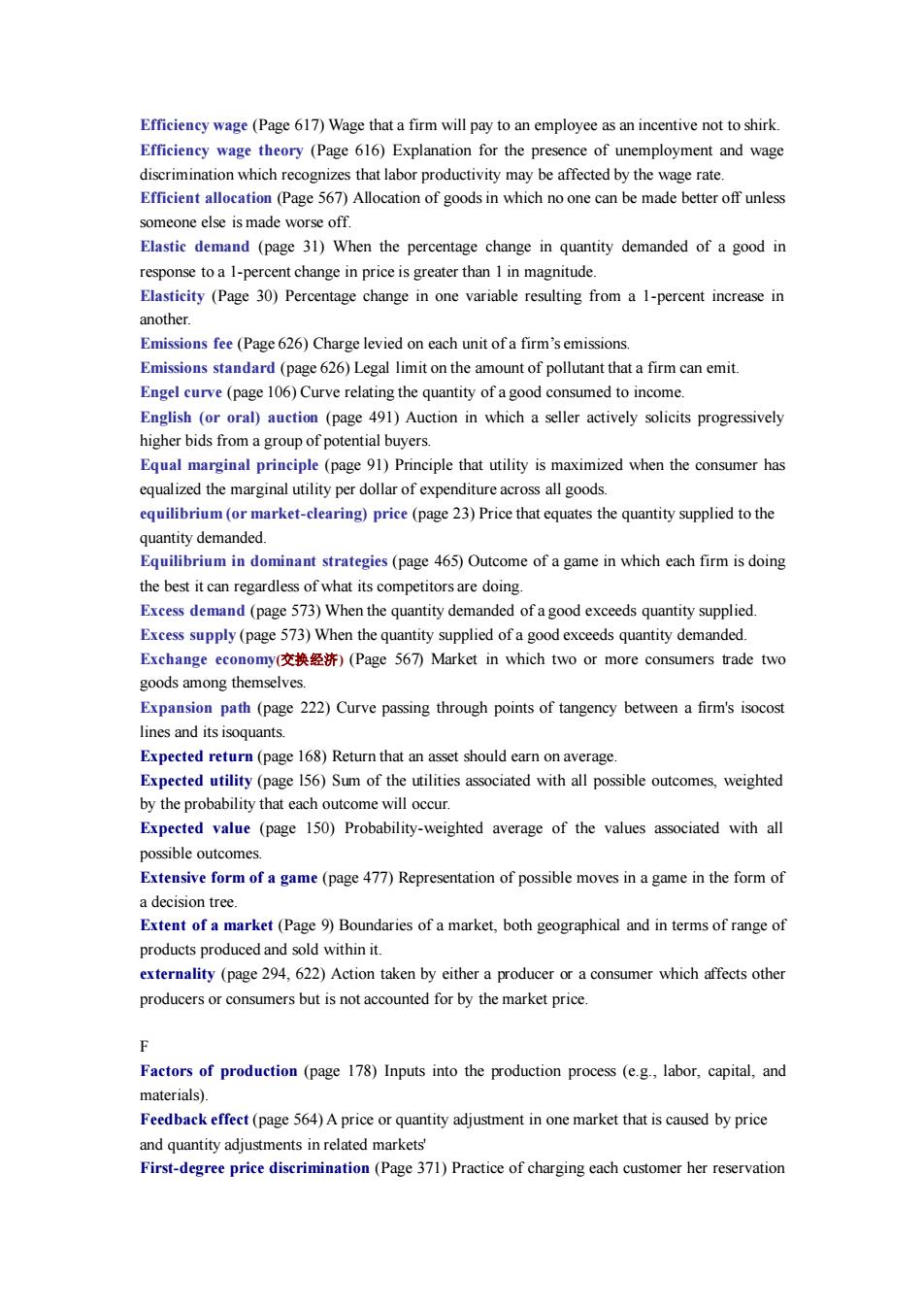
Efficieney wage(Page 617)Wage that a firm will pay to an employee as an incentive not to shirk. discrimination which recognizes that labor productivity may be affected by the wage rate. Efficient allocation (Page 567)Allocation of goods in which no one can be made better off unless someone else is made worse off. Elastie demand (page 31)When the percentage change in quantity demanded of a good in ool0Egeneeomaaee another. Emissions fee (Page 626)Charge levied on each unit of a firm's emissions Emissions standard(page 626)Legal limit on the amount of pollutant that a firm can emit. Engel urve(page 106)Curve relating the quantity of agood consumed to income English(rral)(page 491)Auction in which a sller actively solicits progressively higher bids from a group of potential buyers. Equal marginal prineiple(page 91)Principle that utility is maximized when the consumer has equalized the marginal utility per dollar of expenditure across all goods equilibrium(ormarket-cearing)price(page 23)Price that equates the quantity supplied to the i domit Oome f which Sh fim is oine ad the best it can regardless of what its competitors are doing. Excess demand (page 573)When the quantity demanded of a good exceeds quantity supplied. Excess supply (page 573)When the quantity supplied of a good exceeds quantity demanded. Exchange y(交换经济)(Pag 56)M rket in which two or more sumers trade two goods among themselve Expansion path (page 222)Curve passing through points of tangency between a firm's isocost lines and its isoquants Expected return(page 168)Return that an asset should earn on average Expe age 56)Sum of associated with all possible outcomes weighted iyhatcach ut ill oce Expected value (page 150)Probability-weighted average of the values associated with all possible outcomes Extensive form of a game(page 477)Representation of possible moves in a game in the form of a decision tree (PageBoundaries of a market,both geographical and in terms of range of products produced an od withinit externality (page 294.622)Action taken by either a producer o a consumer which affects other producers or consumers but is not accounted for by the market price. (page 178)Inputs into the poduction process (,capital,an materials) Feedback effect(page 564)A price or quantity adjustment in one market that is caused by price and quantity adjustments in related markets First-degree price discrimination (Page 371)Practice of charging each customer her reservation
Efficiency wage (Page 617) Wage that a firm will pay to an employee as an incentive not to shirk. Efficiency wage theory (Page 616) Explanation for the presence of unemployment and wage discrimination which recognizes that labor productivity may be affected by the wage rate. Efficient allocation (Page 567) Allocation of goods in which no one can be made better off unless someone else is made worse off. Elastic demand (page 31) When the percentage change in quantity demanded of a good in response to a 1-percent change in price is greater than 1 in magnitude. Elasticity (Page 30) Percentage change in one variable resulting from a 1-percent increase in another. Emissions fee (Page 626) Charge levied on each unit of a firm’s emissions. Emissions standard (page 626) Legal limit on the amount of pollutant that a firm can emit. Engel curve (page 106) Curve relating the quantity of a good consumed to income. English (or oral) auction (page 491) Auction in which a seller actively solicits progressively higher bids from a group of potential buyers. Equal marginal principle (page 91) Principle that utility is maximized when the consumer has equalized the marginal utility per dollar of expenditure across all goods. equilibrium (or market-clearing) price (page 23) Price that equates the quantity supplied to the quantity demanded. Equilibrium in dominant strategies (page 465) Outcome of a game in which each firm is doing the best it can regardless of what its competitors are doing. Excess demand (page 573) When the quantity demanded of a good exceeds quantity supplied. Excess supply (page 573) When the quantity supplied of a good exceeds quantity demanded. Exchange economy(交换经济) (Page 567) Market in which two or more consumers trade two goods among themselves. Expansion path (page 222) Curve passing through points of tangency between a firm's isocost lines and its isoquants. Expected return (page 168) Return that an asset should earn on average. Expected utility (page l56) Sum of the utilities associated with all possible outcomes, weighted by the probability that each outcome will occur. Expected value (page 150) Probability-weighted average of the values associated with all possible outcomes. Extensive form of a game (page 477) Representation of possible moves in a game in the form of a decision tree. Extent of a market (Page 9) Boundaries of a market, both geographical and in terms of range of products produced and sold within it. externality (page 294, 622) Action taken by either a producer or a consumer which affects other producers or consumers but is not accounted for by the market price. F Factors of production (page 178) Inputs into the production process (e.g., labor, capital, and materials). Feedback effect (page 564) A price or quantity adjustment in one market that is caused by price and quantity adjustments in related markets' First-degree price discrimination (Page 371) Practice of charging each customer her reservation